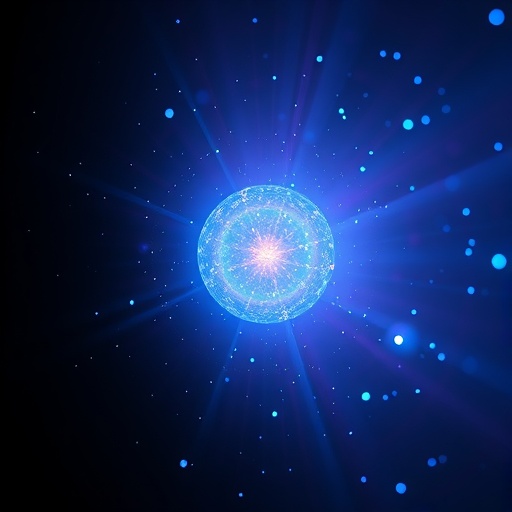In the ever-evolving landscape of optical imaging, a groundbreaking study has emerged that may redefine how scientists capture and analyze ultra-confined optical near fields. Researchers led by Yang, Li, and Tang have introduced a novel weak-disturbance imaging technique that pushes the boundaries of spatial resolution and sensitivity without compromising the delicate nature of the near-field interactions. Published in Light: Science & Applications, this work heralds a new era for nanoscale optics, with profound implications for photonic device engineering, materials characterization, and fundamental physics.
Optical near fields, which exist in the immediate vicinity of nanoscale structures, possess extraordinary spatial confinement and carry rich electromagnetic information crucial for understanding light–matter interactions at subwavelength scales. The challenge has long been to image and characterize these fields with minimal perturbation, as conventional probes or strong field interactions tend to distort the near-field distribution. The team’s approach centers on minimizing the external disturbance while achieving highly sensitive measurements, an approach that bridges a significant gap in nanoscale optical diagnostics.
Traditional near-field microscopy methods typically rely on strong field interactions, where the imaging probe influences the optical environment it intends to measure. This has artificially altered the local electromagnetic landscape, obscuring the true nature of the nanoscale fields and limiting quantitative fidelity. The weak-disturbance method introduced by the authors circumvents these challenges by carefully engineering the probe and employing sophisticated detection schemes that record the near-field signals with unprecedented delicacy.
Fundamentally, the new technique leverages subtle scattering signals that are orders of magnitude weaker than those typically detected in near-field imaging. Detecting these faint signals requires advanced noise suppression strategies and ultra-sensitive photodetectors, alongside precise control of probe positioning. This combination enables the acquisition of near-field maps that faithfully represent the natural electromagnetic environment surrounding nanostructures.
Experimentally, the study demonstrates imaging of ultra-confined optical near fields on plasmonic and dielectric nanostructures with remarkable clarity. The imaging results capture fine details previously obscured or distorted by stronger probing mechanisms. The researchers validated their findings against theoretical simulations, underscoring the method’s robustness and accuracy in quantifying near-field distributions without introducing artificial artifacts.
One of the key breakthroughs lies in the tailored design of the probe tip, which minimizes back-action while maintaining optical sensitivity. The probe interacts weakly with the near field, effectively acting as a passive observer rather than an invasive participant. This subtlety is crucial for applications where maintaining the intrinsic playout of electromagnetic interactions is essential, such as in nonlinear optics and quantum photonics.
Beyond merely imaging, the technique facilitates the characterization of near fields in terms of intensity, phase, and polarization, providing a comprehensive picture of the nanoscale electromagnetic environment. This multidimensional perspective opens avenues for more nuanced studies of optical phenomena, including local density of states mapping and investigation of anisotropic responses in complex nanostructures.
The application potential for this weak-disturbance imaging is vast. In photonic device fabrication, it allows engineers to pinpoint subtle electromagnetic hotspots, enabling enhanced design optimization for sensors, waveguides, and light-emitting devices. The capacity for minimally invasive measurement also makes it instrumental in biological imaging, where delicate structures must be examined without perturbation.
The research also paves the way for exploring novel materials with exotic optical properties at the nanoscale. By accurately capturing the near-field signatures of two-dimensional materials, metamaterials, and topological photonic structures, the method provides a vital tool for accelerating materials discovery and understanding emergent quantum optical effects.
Importantly, the approach’s versatility allows it to be integrated with existing microscope platforms, potentially upgrading a broad range of experimental setups with minimal modification. This practical adaptability promises to disseminate the technique widely within the research community, fostering rapid adoption and innovation.
From a theoretical standpoint, the weak-disturbance imaging approach challenges the conventional wisdom that high spatial resolution must come at the expense of perturbative influence. By demonstrating that ultra-sensitive detection techniques can capture near-field data without significant back-action, the study offers new insights into the measurement problem in nanoscale optics.
The work sparks intriguing questions about the ultimate limits of optical microscopy. If near-field interactions can be monitored with minimal disturbance, could this lead to new quantum-limited sensing modalities or even the ability to probe the quantum nature of light–matter interaction directly? These prospects motivate further exploration and refinement of the technique.
Moreover, the interdisciplinary nature of the research, blending nanophotonics, materials science, and advanced detection technologies, exemplifies the collaborative spirit needed to tackle complex challenges in modern science. The convergence of expertise has yielded a breakthrough that is likely to inspire subsequent studies and technological developments.
As the field moves forward, the weak-disturbance imaging method stands as a transformative tool for both fundamental research and applied sciences. By rendering the invisible visible in an unperturbed manner, it opens unparalleled opportunities to unlock the mysteries of the nanoscale electromagnetic world with clarity and precision.
In conclusion, the study by Yang, Li, Tang, and collaborators represents a milestone in optical near-field imaging. Their weak-disturbance approach harmonizes the tension between sensitivity and non-invasiveness, setting a new standard for nanoscale optical characterization. With far-reaching implications for photonics, materials science, and quantum technologies, this advance is poised to ignite widespread interest and drive innovation across multiple disciplines.
Subject of Research: Optical near-field imaging and characterization techniques
Article Title: Weak-disturbance imaging and characterization of ultra-confined optical near fields
Article References:
Yang, L., Li, Y., Tang, J. et al. Weak-disturbance imaging and characterization of ultra-confined optical near fields. Light Sci Appl 14, 358 (2025). https://doi.org/10.1038/s41377-025-01951-6
Image Credits: AI Generated
DOI: https://doi.org/10.1038/s41377-025-01951-6
Tags: electromagnetic information in opticsimplications for fundamental physics researchlight-matter interactions at subwavelength scalesminimal disturbance imaging methodsnanoscale diagnostics challengesnanoscale optics advancementsnear-field microscopy innovationsoptical near-field characterizationphotonic device engineering implicationsspatial resolution in optical imagingultra-confined optical near fieldsweak-disturbance imaging technique





